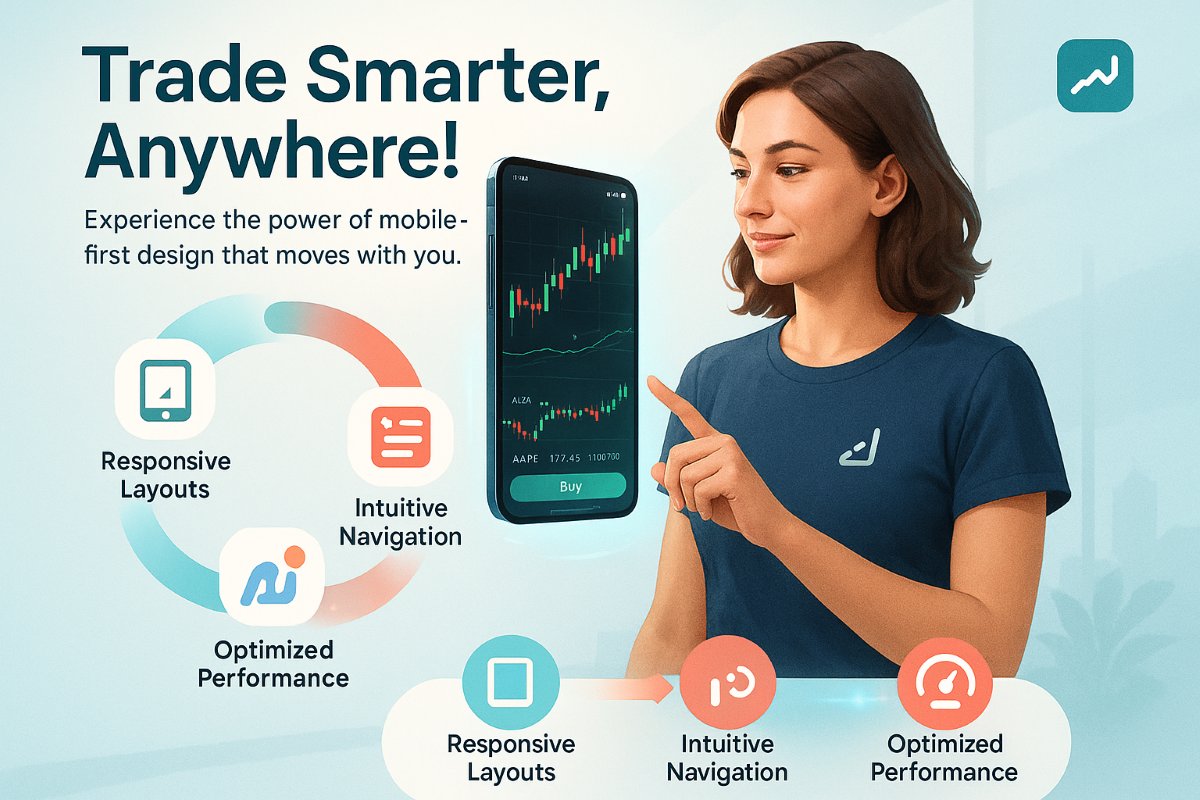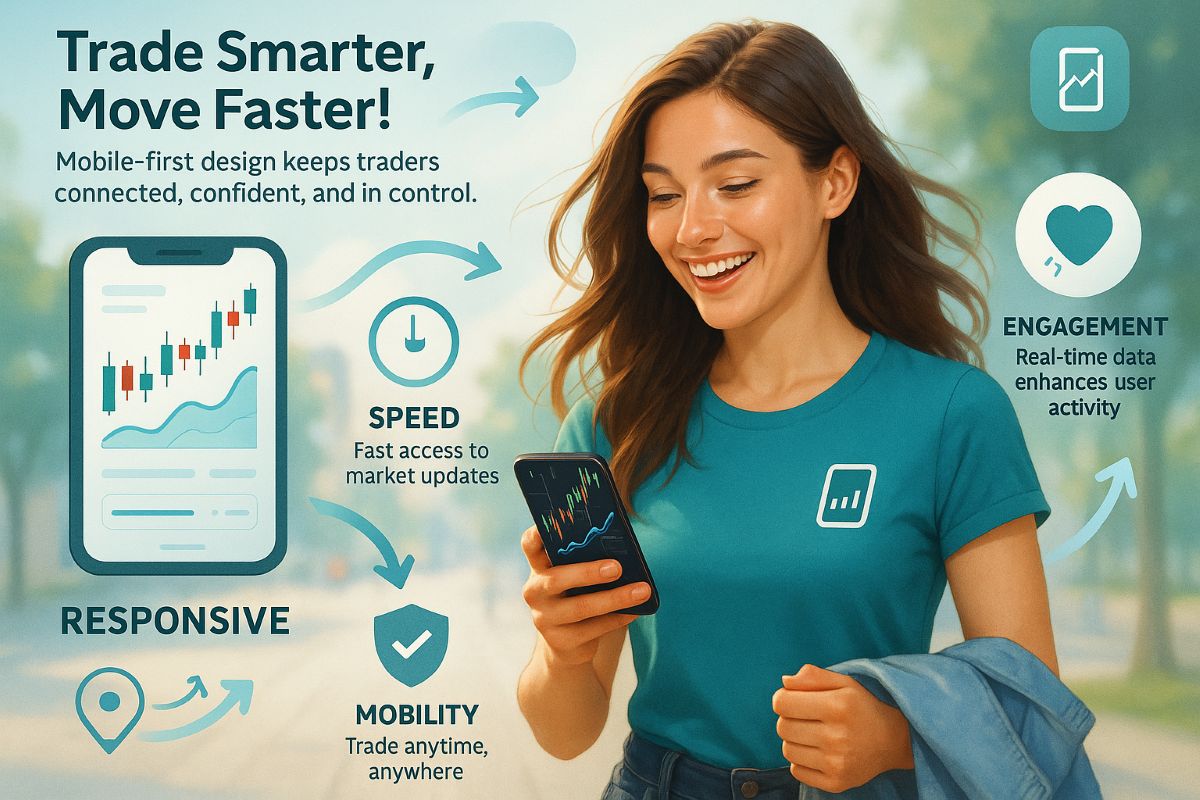Trading apps can feel confusing if they don’t work well on mobile. Many users struggle with slow loading, clunky layouts, or hard-to-read screens. These issues often lead to frustration and abandonment of the app.
Here’s a fact: Over 90% of internet users access websites using their phones. This makes mobile-first design crucial for any trading app aiming to attract and retain users. In this post, you’ll learn why mobile-first design matters and how it enhances usability, speeds up trades, and ensures traders remain engaged.
Stay tuned to discover what makes a trading app truly user-friendly!
Importance of Mobile-First Design for Trading Apps
More people now trade on their phones than ever before. Mobile-first design ensures trading apps work smoothly on smaller screens without sacrificing functionality. A cluttered or slow app can frustrate users, causing them to abandon it for better competitors.
Clear navigation makes a huge difference in user satisfaction. Fast-loading pages and real-time updates keep traders informed about price changes without delays. Trading apps need to prioritize simplicity and speed to cater to both new and experienced traders who demand quick decisions.
Key Features of Mobile-First Trading App Design

Mobile-first trading apps prioritize simplicity and efficiency. They give users control with interfaces designed for quick decisions.
Responsive layouts for various screen sizes
Layouts adjust to different devices like a chameleon changing colors. A trading app designed with responsive layouts adjusts itself to fit perfectly on smartphones, tablets, or desktop screens.
Users get the same polished experience whether viewing charts on a big monitor or checking stock prices on their phone during lunch.
"Good design means no pinching or zooming needed," said a seasoned UI expert. Buttons remain clickable and text stays readable regardless of screen size. Traders save time while switching between gadgets without losing functionality.
Intuitive navigation for seamless user experience
A clean layout means nothing if users can’t find what they need quickly. Trading apps must guide users with straightforward menus, clear labels, and logical pathways. Beginners want simplicity without feeling lost, while advanced traders require quick access to intricate tools.
Position high-priority features front and center to reduce unnecessary clicks. Apply consistent design patterns across sections for familiarity. Small details like a search bar or dropdown filters save time during high-pressure trades.
Real-time data updates and notifications
Trading apps thrive on accurate and instant updates. Price changes, market trends, and analytics refresh in real time to help users make quick decisions. Notifications deliver alerts about stock movements or personalized trading opportunities without delay. Staying informed allows traders to act fast in volatile markets—especially when researching affordable opportunities such as how to find penny stocks on Robinhood, where quick reactions can make all the difference.
Staying informed allows traders to act fast in volatile markets. Real-time data reduces the risk of missing out while improving overall efficiency. Next, we’ll discuss how improved performance enhances the mobile experience further.
Optimized performance for faster loading times
Quick loading times maintain user interaction and avoid frustration. Slow apps can result in missed trades, reduced activity, and dissatisfied traders. Enhanced performance ensures users receive real-time updates promptly.
Effective design reduces data consumption while enhancing speed. Streamlined coding and improved visuals allow apps to operate quickly on any connection type. This helps users concentrate on trading rather than waiting for screens to respond.
Benefits of Mobile-First Design in Trading Apps

Mobile-first design simplifies trading, making apps easier to use for everyone. It keeps users coming back by creating smooth and fast experiences.
Enhanced user engagement and retention
Clear visuals and fast responses keep traders engaged. Apps that load quickly avoid frustrating delays during critical trades, building trust with users. Real-time data updates make tracking investments feel seamless, turning occasional visitors into daily users.
Simplified designs reduce confusion and increase confidence in navigation. Traders who find tools easy to use stick around longer for consistent trading sessions. This leads directly to increased trading activity through improved accessibility.
Increased trading activity through better accessibility
Mobile accessibility has made trading more convenient for users across all levels. Trading apps designed with mobile-first principles let traders place orders, monitor markets, and receive live updates from anywhere.
Beginners can learn quickly by accessing resources on the go, while advanced traders benefit from acting on opportunities without delay.
Responsive design adjusts smoothly to devices of any size. This allows desktop-level functionality directly in the palm of your hand. Immediate access reduces missed trades during volatile market shifts, keeping users connected and informed at all times.
Improved user satisfaction with simplified interfaces
Simplified interfaces eliminate unnecessary clutter, letting users focus on what truly matters. Clear buttons, readable fonts, and straightforward menus create a smooth experience.
Traders can execute actions quickly without digging through layers of options. This approach reduces confusion while increasing confidence during trades.
A less complicated design helps both beginners and seasoned traders feel at ease. Novices learn faster with intuitive layouts guiding them step by step. Experienced users appreciate the speed of navigating efficiently to key tools or data insights.
Simplification isn't just about aesthetics; it directly supports smarter decision-making on-the-go.
Best Practices for Mobile-First Trading App Design

Creating a trading app is like constructing a reliable bridge—it requires a solid base. Prioritize the activities users engage in most and make everything else straightforward.
Prioritizing core functionalities over additional features
Focusing on core functionalities keeps trading apps efficient and easy to use. Traders need quick order execution, real-time data updates, and reliable transaction systems. Adding unnecessary features can reduce performance and irritate users.
Every feature should serve a purpose connected to trading success. A crowded interface takes attention away from important tasks like analyzing market trends or tracking portfolios.
Simplicity improves usability, allowing both beginners and experienced traders to navigate comfortably.
Conducting user behavior analysis for tailored experiences
Studying user behavior helps understand traders' habits, preferences, and challenges. Tracking common actions, like stock searches or trade executions, reveals patterns in app usage.
Developers can then improve features to align with these needs without overloading the interface.
Behavior analysis also identifies obstacles that frustrate users. For instance, tracking abandoned trades may highlight confusing layouts or slow response times. Addressing these issues enhances mobile usability and encourages users to return for more trading activity.
Steps like this lead smoothly into secure transaction processes.
Incorporating secure and efficient transaction processes
Trading apps must handle transactions with speed and accuracy. A secure payment gateway protects users from potential fraud or data breaches. Encryption technologies, like SSL certificates, safeguard sensitive financial details during each transaction.
Simplifying verification processes can reduce delays without compromising security. Instant confirmation of trades keeps users confident in the app’s reliability. Layers of authentication, such as biometrics or two-factor codes, add an extra barrier against unauthorized access while maintaining ease of use for traders at all levels.
👉For a deeper dive into how trading platforms secure their backend integrations and protect sensitive data flows, see this detailed guide on secure APIs in SaaS trading.
Conclusion
A mobile-first design keeps trading simple and efficient. It grabs attention with easy navigation and fast performance. Users stick around because their experience feels smooth and customized to their needs.
Smart designs turn casual traders into loyal customers. A great app builds trust while driving activity forward.



